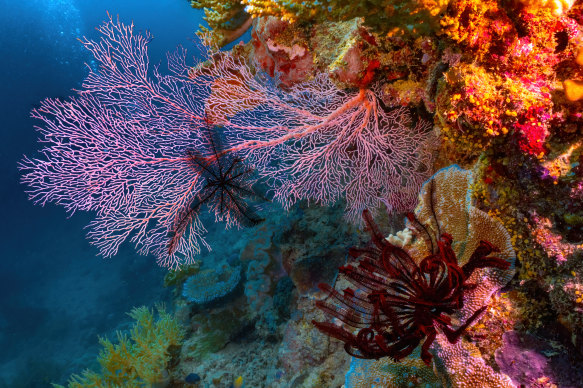This was published 8 months ago
Opinion
Nature positive? How about we stop being nature negative first
Caitlin Fitzsimmons
Environment reporterAustralia is part of an exclusive club of 17 countries that are so biodiverse they are considered “megadiverse”.
Despite covering less than 10 per cent of the world’s area, megadiverse nations such as Australia, Brazil and Madagascar support more than 70 per cent of global biodiversity.
Australia is home to 600,000 to 700,000 native species – many of which are found nowhere else in the world.
Yet Australia has been called the “global epicentre of extinctions”, based on our poor track record since 1788. As of August this year, 2118 of our native species and 103 ecological communities were listed as threatened under national environmental law.
The Albanese government wants to change this; it has not only talked a lot about a “nature positive” agenda since it won power, it has also significantly increased its spending on the environment. This week Environment Minister Tanya Plibersek is co-hosting the Global Nature Positive Summit in Sydney with her NSW counterpart, Penny Sharpe.
Yet the government’s slow progress in reforming the Howard-era Environment Protection and Biodiversity Conservation Act has left many in the environment movement frustrated. These are the federal environmental laws declared “not fit for purpose” by respected businessman Graeme Samuel, and which Plibersek applied in her recent approval of three massive coal mines.
The problem is, you can’t be nature positive unless you first stop being nature negative.

Environment Minister Tanya Plibersek is hosting the Global Nature Positive Summit this week.Credit: Oscar Colman
Plibersek has said she wants to set up a “nature repair market”, which would be somewhat like a carbon market but to fund environmental projects such as mangrove restoration or hunting feral cats. Such schemes are already operating in the private sector.
From an economic perspective, this idea has merit as long as there is oversight to ensure the projects have integrity. But it is even more important to end incentives for activities that harm the environment – what you might call nature-negative subsidies.
The term “nature positive” did not come out of thin air. It was embraced in the Global Biodiversity Framework adopted by Australia and other countries at the 2022 United Nations biodiversity conference – similar to the climate COP but for biodiversity – in Kunming and Montreal.

Ninety-nine per cent of Australians think it’s important to protect natural wonders such as the Great Barrier Reef for future generations.Credit: Getty Images
The biodiversity framework includes a commitment to eliminate, phase out or reform incentives including subsidies that are harmful to biodiversity. Signatories are required to identify these subsidies by 2025 and progressively reduce them by at least $US500 billion a year by 2030.
Yet last week Plibersek launched Australia’s Strategy for Nature 2024-30, which purportedly aligns to this framework but ignores the part about subsidies.
Ahead of this week’s summit the Biodiversity Council has crunched the numbers and calculates that federal subsidies that harm biodiversity amount to $26.3 billion a year. This is based on 2022-23 figures, using OECD methodology.
That dwarfs the $612.74 million in federal government funding for biodiversity in the same year.
Environmentally harmful subsidies include both the underpricing of natural resources and incentives to increase production.
The Biodiversity Council report only includes Commonwealth subsidies – not, for example, the millions of dollars the NSW government spends to prop up the unprofitable, state-owned Forestry Corporation.
The report identifies $18.6 billion of recurrent direct subsidies, $3.9 billion of non-recurrent direct subsidies and $3.8 billion of recurrent indirect subsidies (mostly tax concessions).
The Biodiversity Council argues that the recurring subsidies likely to have the most adverse impacts on biodiversity are the $7.5 billion a year for the fuel tax credit scheme and the $7.7 billion a year in spending on road transport projects. Among the largest one-off incentives is the $1.9 billion Middle Arm Sustainable Development Precinct in Darwin, a key enabler for expanding production of shale gas from fracking in the Beetaloo Sub-basin.
A Plibersek spokesperson says the government has committed to the global biodiversity framework in full but has focused its action plan on key areas of environmental decline as identified in the State of the Environment report. The government is committed, the spokesperson says, to meeting its deadline to identify subsidies, but notes its report is not due until February 2026.
You can’t be nature positive unless you first stop being nature negative.
For a long time now, the climate crisis has dominated the environmental agenda, leaving nature even more sidelined than it used to be. The focus on climate is understandable, but the devastating decline in global biodiversity is also an existential threat.
The nature-positive movement seems to be an attempt for the broader environment movement to emulate the climate movement’s success in using the language of economics and the structures of markets.
Philanthropy Australia figures suggest only 5 per cent of donations from charitable foundations go to environmental causes – and that includes animal welfare and climate.
Despite recent increases under the Albanese government, federal funding to protect and restore biodiversity has averaged $475 million a year for the past decade. In 2024 it was $761.6 million, including activities such as threatened species recovery, feral animal control, and work to reduce pollution to the Great Barrier Reef.
A Plibersek spokesperson says spending on the environment is at record levels, reaching $9 billion over the forward estimates (the current year plus three more). This would be higher still if you include environmental buybacks of water, for example, to help restore the Murray-Darling basin.
In considering how to remove nature-negative laws and economic incentives, Plibersek should know she has the backing of most Australians.
A nationally representative survey of 1619 people by YouGov found 99 per cent of Australians say it is important that future generations can enjoy the country’s natural wonders. Four out of five Australians are concerned that more native species will become extinct, and that concern is high no matter age or political allegiance.
Seven out of 10 voters say the federal government needs to do more to protect and restore nature, and nine out of 10 think businesses need to do more. Finally, 86 per cent support Australia having stronger national environment laws.
Plibersek should be emboldened by that but equally, environmentally conscious voters need to clearly understand the choice at the next national election.
Opposition Leader Peter Dutton has all but declared war on the environment this year. He has vowed to slash “green tape” for mining projects, defund not-for-profit legal centre the Environmental Defenders Office, and limit the ability of third parties to challenge decisions under environmental laws. He has signalled he will scrap the nation’s legally binding 2030 climate target and risk Australia’s membership of the Paris Agreement on climate change.
Most recently, at a minerals industry event in September, he promised: “A Dutton Coalition government will be the best friend that the mining and resources sector in Australia will ever have.”
Now that’s nature negative.
Ross Gittins is on leave.
Get a weekly wrap of views that will challenge, champion and inform your own. Sign up for our Opinion newsletter.